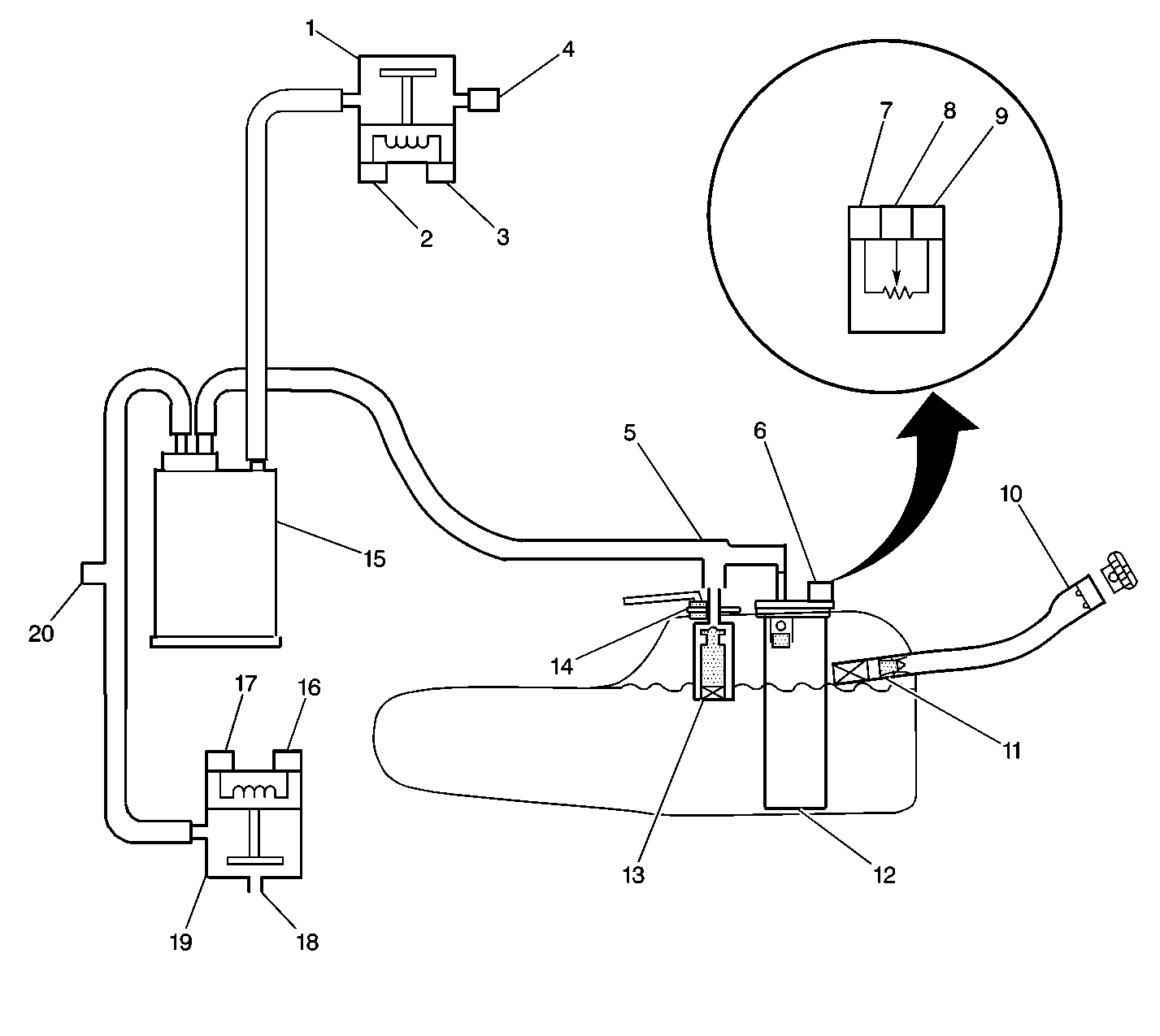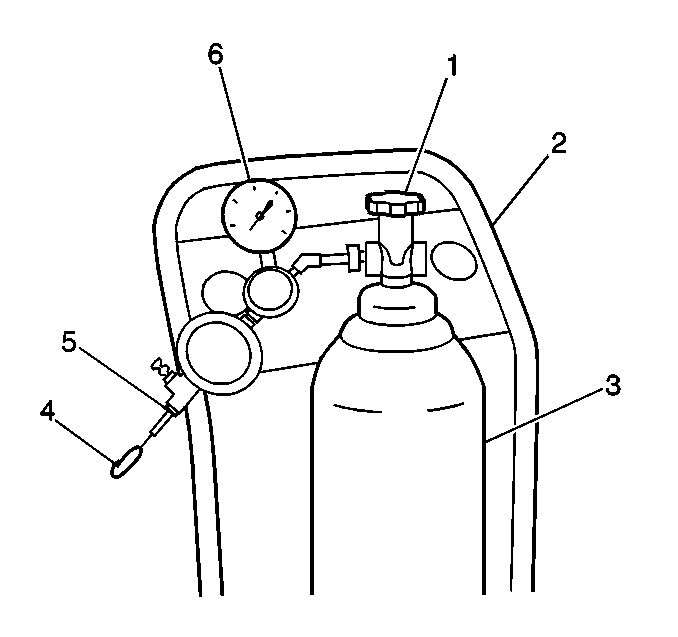Refer to
EVAP Control System Overview

EVAP System Description
The evaporative system includes the following components:
| • | The fuel tank. |
| • | The EVAP vent valve/solenoid. |
| • | The fuel tank pressure sensor. |
| • | The fuel pipes and hoses. |
| • | The fuel fill cap. |
| • | The EVAP vapor lines. |
| • | The EVAP purge lines. |
| • | The EVAP canister. |
| • | The EVAP canister purge valve/solenoid. |
The EVAP purge valve/solenoid allows manifold vacuum to purge the canister. The Powertrain Control Module (PCM) supplies a Ground to energize the purge valve/solenoid (purge ON). The EVAP purge valve/solenoid control is Pulse Width Modulated (PWM) or Turned ON and OFF several times a second. The duty cycle (pulse width) is determined by engine operating conditions including load, throttle position, coolant temperature and ambient temperature. The duty cycle is calculated by the PCM and the output is commanded when the appropriate conditions have been met.
The EVAP Vent valve/solenoid is used to seal the EVAP system during diagnostic tests. The fuel tank pressure sensor is used to monitor vacuum in the system during the diagnostic tests.
A stuck closed EVAP purge valve/solenoid, Stuck open EVAP vent valve/solenoid, disconnected or damaged EVAP Purge line or vent hose, leaking fuel cap, or fill neck should set a DTC P0440. A small leak in the EVAP system should set a DTC P0442 An EVAP vent valve/solenoid stuck closed, a restricted vent hose, or a blocked EVAP canister should set a DTC P0446. A continuous purge condition with no purge commanded by the PCM (EVAP purge valve/solenoid stuck open or leaking) should set a DTC P1441. Refer to the DTC tables for further diagnostic procedures regarding the EVAP system.
Diagnostic Aids
Check for the following conditions:
| • | Cracked or punctured EVAP canister. |
| • | Damaged or disconnected source vacuum line, EVAP purge line, vent hose or fuel tank vapor line. |
| • | Poor connection at the PCM. |
| • | Inspect harness connectors for backed out terminals, improper mating, broken locks, improperly formed or damaged terminals, and poor terminal to wire connection. |
| • | Damaged harness. Inspect the wiring harness to the EVAP vent valve/solenoid, the EVAP purge valve/solenoid, and the fuel tank pressure sensor for an intermittent open or short circuit. |
| • | Kinked, pinched or plugged vacuum source, EVAP purge, or fuel tank vapor line. Verify that the lines are not restricted. |
| • | Use the following procedure to check for a carbon release condition that could plug the system. |
| 1. | Turn off the ignition switch. |
| 2. | Remove the EVAP canister purge valve/solenoid. Refer toEVAP Canister Purge Valve Replacement . |
| 3. | Lightly tap the canister purge valve on a clean work area looking for carbon particles exiting either of the vacuum ports. |
| 4. | If no carbon release is evident, reinstall the components and continue with the DTC P0440 diagnostic table. If carbon is being released from either component, continue with this service procedure. |
| 5. | Remove the charcoal canister from the vehicle. |
| 6. | Ensure that the main cylinder valve is turned off on the

|
| 7. | Disconnect the black hose that connects the nitrogen cylinder to the EVAP purge/pressure diagnostic station at the pressure regulator by unscrewing the knurled nut on the regulator. No tools are required to remove the black hose from the regulator. |
| 8. | Using a section of vacuum line, connect one end over the open threaded fitting of the EVAP purge/pressure diagnostic station pressure regulator. |
| 9. | Connect the remaining end to the purge valve end of the EVAP purge line at the vehicle and turn on the main nitrogen cylinder valve. Continue to blow any debris from the purge line for 15 seconds. |
| 10. | Return the EVAP Pressure/Purge Diagnostic Station to its original condition by reinstalling the black hose that was disconnected in step 7. |
| 11. | Replace the following components: |
| • | The EVAP canister purge valve. Refer to EVAP Canister Purge Valve Replacement . |
| • | The EVAP canister. Refer to EVAP Canister Replacement . |
Test Description
Number(s) below refer to the step number(s) on the Diagnostic Table:
-
The powertrain OBD System Check promps you to complete some of the basic checks and store the freeze frame and failure records data on the Scan Tool if appplicable.
-
If a vent valve or EVAP purge valve electrical malfunction is present, the purge system will not operate correctly. Repairing the electrical malfunction that caused the DTC to set will very likely correct the condition.
-
Checks for a fuel tank pressure sensor stuck high condition. The fuel tank pressure must be relieved by removing the canister line from the Purge Valve. The fuel fill cap will not relieve the fuel tank pressure due to a check valve in the filler neck. The check valve seals when pressure is applied to prevent vapors from escaping through the filler neck. The Scan Tool should read within +/- 1.0 in. H2O of the specified value.
-
Checks for a Large Leak in the EVAP system.
-
Verifies that the fuel tank pressure sensor accurately reacts to EVAP system pressure changes. The EVAP station is pressurizing a sensor that normally reads vacuum. The tech II reads high pressure at 0 volts and high vacuum at 5 volts. the Tech II can only read a max pressure of 6.0 inches of H2O (0 Volts). However the EVAP Service station can pressurize the system to much higher pressures. The Scan Tool value should be within +/- 0.5 of the specified value.
-
Checks for a stuck closed EVAP Vent Valve/Solenoid. The value should decrease to within +/- 1.0 in Hg of the specified value.
-
Checks for a leaking or stuck open EVAP canister purge valve/solenoid, The scan tool should read within +/- 1.0 in. HG of the specified value.
-
Ensures that sufficient source vacuum is present at the EVAP canister purge valve/solenoid.
-
Checks for a small leak in the EVAP system.
Step | Action | Value(s) | Yes | No | ||||
|---|---|---|---|---|---|---|---|---|
Was the Powertrain OBD System Check performed? | -- | |||||||
|
Important: Visually/Physically inspect for the following conditions:
Is DTC P0443 Evaporative Emission (EVAP) Purge Solenoid Control Circuit or DTC P0449 Evaporative Emission (EVAP) Vent Solenoid Control Circuit also set? | -- | Go to the DTC first | ||||||
Is the Fuel Tank Pressure near the specified value? | 0 in H2O | |||||||
|
Important: Before continuing with diagnosis, zero the EVAP Pressure and Vacuum (inches of H2O) Gauges on the J 41413 EVAP Pressure/Seal Diagnostic station. Important: Do not exceed the pressure in the specified value.
Can specified value be achieved? | 5 in H2O | |||||||
Is the fuel tank pressure near the specified value? | 5 in H2O | |||||||
Does the EVAP pressure gauge decrease to near the second specified (lower) value within 2 minutes with the rotary switch in the "Off/Hold" position? | 5 in H2O | Go to DTC P0446 Evaporative Emission (EVAP) Vent System Performance | ||||||
Is vacuum level above the specified value? | 0 in Hg | |||||||
Is vacuum level above the specified value? | 15 in Hg | |||||||
9 |
Is the Fuel Tank Pressure near the specified value? | 0 in H2O | Go to DTC P0453 Fuel Tank Pressure Sensor Circuit High Voltage | |||||
10 |
Is action complete? | 0 in H2O | -- | |||||
11 |
Was a problem found? | -- | Go to DTC P0452 Fuel Tank Pressure Sensor Circuit Low Voltage | |||||
12 |
Was a problem found? | -- | -- | |||||
13 |
Important: Check for carbon release into the EVAP system. Refer to diagnostic Aids.
Is the action complete? | -- | ||||||
|
Important:: Do not exceed the pressure in the specified value.
Does the EVAP pressure decrease to less than the second specified (lower) value within 2 minutes with the rotary switch in the "OFF/Hold" position? | 15 in H2O 10 in H2O | Go to DTC P0442 Evaporative Emission (EVAP) System Small Leak Detected | System OK |
